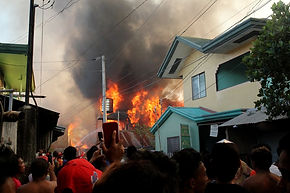
Disaster Readiness and Risk Reduction
Lesson 3: Human Induced Hazards
Technological Hazards
Technological hazards have little or no warning to precede the incident. These dangers originate from industrial accidents, dangerous procedures, infrastructure failures or certain human activities, which may cause the loss of life or injury, property damage, social and economic disruption or environmental degradation
Fire
Fire is composed of three elements – heat, fuel, and oxygen which when combined will result in a chemical reaction called burning. The leading cause of death in a fire, by a three- to-one ratio over burns, is asphyxiation (choking sensation). Fire consumes the oxygen in the air, while increasing the concentration of deadly carbon monoxide and other toxic gases in the atmosphere. Inhaling carbon monoxide can cause loss of consciousness or death within minutes. The heat from a hostile fire exceeds anything to which a person is normally exposed. A fully developed room fire has temperatures over 1,100 degrees Fahrenheit. Fire generates a black,impenetrable smoke that blocks vision and stings the eyes. It is impossible to navigate through such smoke, so fire drill participants should practice evacuating buildings by at least two routes
What to do before:
• Develop a School Preparedness Plan.
• Develop building evacuation plans for each
building.
• Post evacuation plans in strategic locations.
• Install fire extinguishers and alarms.
• Educate by means of demonstration to
teachers and students on the proper use of
fire extinguishers.
• Maintain proper signage for fire exits.
• Clear and free fire exits from obstruction.
• Insure the building.
• Check regularly on the security guards and
watchmen.
• Make sure that the public address systems
are loud, clear and functional.
• Assist the professional firemen in their Fire
Prevention and Suppression Drill Program
(Fire Brigade members).
• Conduct regular inspections and safety checks
on electrical outlets.
• Assign personnel who will regularly check
possible areas where fire may start such as
stock room, laboratories, kitchens.
• Maintain a fire safety plan and an education
program to preserve the school to protect
the students from fire.
• Consider escape ladders for multi-storey
school buildings

What to do during:
When fire is detected:
Do’s
• Sound the alarm.
• Advise the fire department.
• Fight the fire with available equipment (for
Kiddie/Junior Fire Marshals and trained
personnel).
• Drop the fire extinguisher if you are using it
and leave if the fire does not immediately die
down.
• Seek the nearest exit not blocked by fire.
• Feel the door, cracks, and doorknob with the
back of your hand before opening the door if
you are escaping through a closed door. The
back of your hand is more sensitive to heat.
• Close windows and doors as you escape from
the fire scene to delay the spread of the fire.
• Use your second way out if you see smoke
or fire in your first escape route. The less
time you are exposed to poisonous gases or
flames, the safer you will be.
• Get out as safely and quickly as you can and
stay away from toxic smoke and gases. Drop,
crawl and go when fire breaks out.
• Crawl low under the smoke to your exit if
you must exit through smoke. Crawling with
your head at a level of one to two feet above
the ground will temporarily provide the best
air.
• Once you are outside, go to your safe meeting
place and send one person to call the Fire
Department, if not already alerted.
• ONCE YOU ARE OUT, STAY OUT
What to do after:
• Coordinate with the Bureau of Fire Protection
and municipal or city engineering office for
building assessment.
• Conduct inventory of school personnel and
students, equipment, fixtures and facilities.
• Report damage/s to proper authorities.
• Give first aid when needed and seek medical
assistance for the seriously injured.
• Stay out of fire-damaged buildings until local
fire authorities say it is safe to re-enter




Environmental Hazards
Red Tide
Red tide refers to the discoloration of water bodies due to the presence of a high level of “bloom” of a group of algae called dinoflagellates, which are toxic and responsible for paralytic shellfish poisoning (PSP)


What to do before:
What to do during:
What to do after:
• Disseminate red tide information, symptoms
and progressions.
• Keep track of and warn regarding media
information on outbreaks of red tide, avoid
ingestion of fish, shell fish, mollusks and crabs
• Monitor progression of symptoms and seek
medical advice.
• Avoid or refrain from eating sea foods while
danger exists.
• Seek medical advice
Socio-Economic, Political, Security
Hazards

Hostage Taking
Terrorists feel that human lives must be endangered in order for their demands to be met. Hostage taking may happen in public/private schools. When it happens, do the following:
What to do before:
• Educate the children at risk.
• Provide negotiation training and obtain
systematic coaching on emergency
preparedness
What to do during:
• Inform the family of the victim.
• Stay as calm as you can and encourage
students/pupils around you to act calmly.
• Concentrate on survival.
• Follow hostage taker’s instructions
What to do after:
• Assist the family of the victim in seeking
justice.
• Offer therapeutic coaching to people to
act resourcefully under stress.

